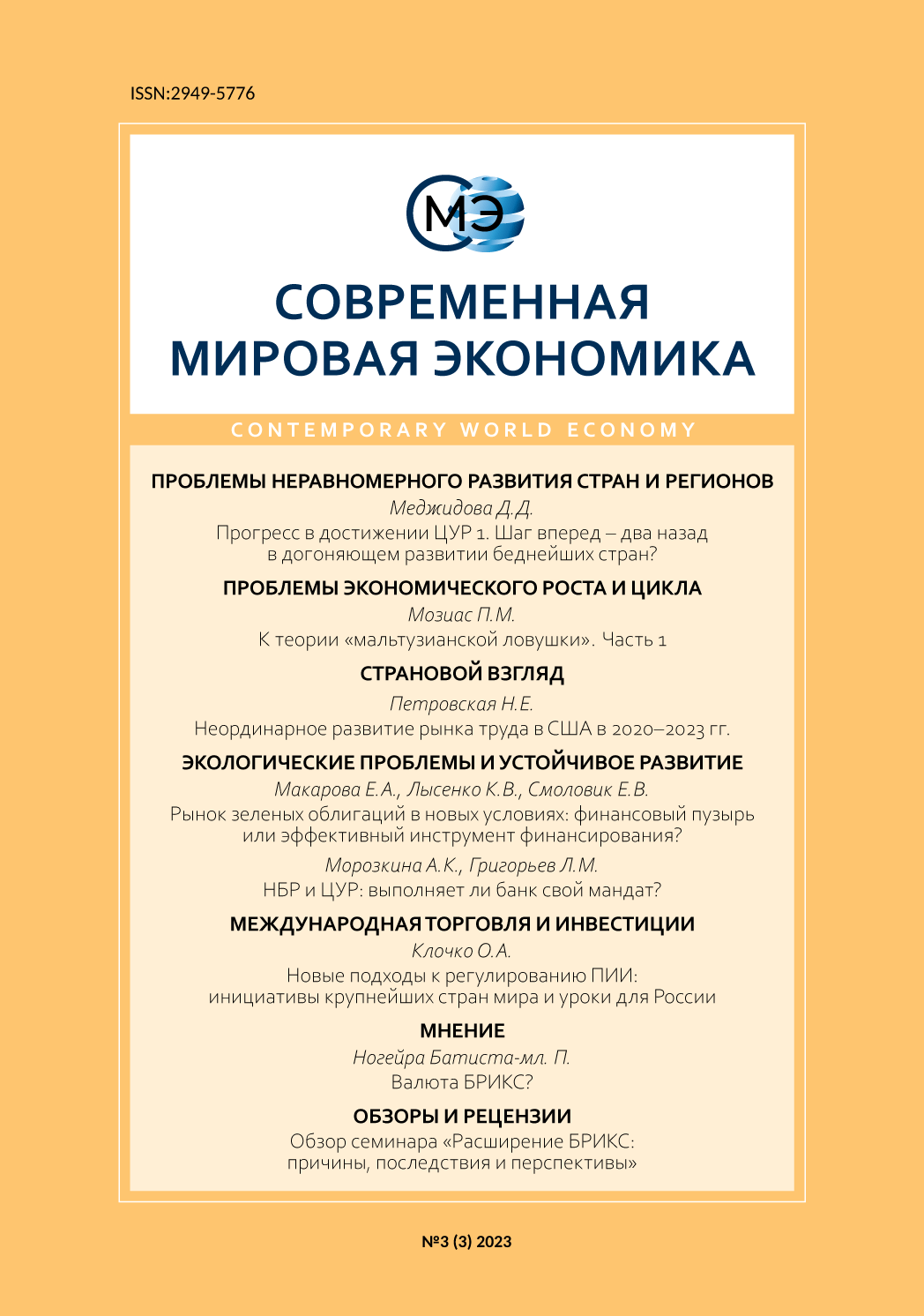Новые подходы к регулированию прямых иностранных инвестиций: инициативы крупнейших стран мира и уроки для России
Аннотация
Статья посвящена изучению актуальных тенденций в области регулирования прямых иностранных инвестиций (ПИИ), вызванных происходящими изменениями во взаимодействии отдельных стран мира и их группировок. Исследуются инструменты и подходы России и ключевых стран – участниц глобального рынка ПИИ к регулированию не только входящих, но и исходящих инвестиций, ранее редко попадавших в поле зрения регуляторов. Усиление контроля за всеми направлениями инвестиционных потоков, а также расширение перечня стратегически важных и чувствительных отраслей страны, участие в которых ограничено для иностранных инвесторов, приводит к тому, что внешняя инвестиционная политика западных стран из инструмента управления внешнеэкономической деятельностью компаний превращается в инструмент обеспечения национальной безопасности и технологического суверенитета. Регулирование ПИИ в России на сегодня представляет собой набор разрозненных мер и носит реактивный характер, не позволяющий поддерживать экономический рост и геополитические интересы страны. В статье обосновывается необходимость пересмотра подходов с целью создания комплексного, соответствующего новым вызовам и реалиям регуляторного инструментария, интегрированного в общую внешнеэкономическую стратегию России и стратегию ее экономической безопасности. По результатам исследования сформулированы цели новой внешней инвестиционной политики России, подходы к регулированию входящих и исходящих инвестиций, а также даны рекомендации по разработке инструментария в области регулирования ПИИ.
Скачивания
Литература
Aksenov, P.A., 2019. The US Foreign Investment Regulation: Trade War Restrictions. International Trade and Trade Policy. No 4. P. 31-41 (in Russian).
Bloomberg, 2023. Europe’s Foreign Subsidy Rules Have China in Its Sights. 12 October 2023. Available at: https://www.bloomberg.com/news/newsletters/2023-10-12/europe-s-foreign-subsidy-rules-have-china-in-its-sights (accessed 01 October 2023).
Cleary & Gottlieb, 2020. CFIUS blocks joint venture outside the United States, 2020. Available at: https://www.clearytradewatch.com/2020/06/cfius-blocks-joint-ventureoutside-the-united-states-releases-2018-2019-data-and-goes-electronic/ (accessed 20 September 2022).
Damgaard, J., Elkjaer, T., Jihannesen, N., 2019. What Is Real and What Is Not in the Global FDI Network? IMF Working Paper, December 2019.
Decree of the President of the Russian Federation No. 302 dated 25 April 2023 “On Temporary Management of Certain Property” (in Russian).
Decree of the President of the Russian Federation No. 208 dated 13 May 2017 “On the Strategy of Economic Security of the Russian Federation for the Period Up to 2030” (in Russian).
Federal Law No. 422-FZ dated 04 August 2023 “On Amendments to Certain Legislative Acts of the Russian Federation” (in Russian).
Federal Law No. 470-FZ dated 04 August 2023 “On Peculiarities of Regulation of Corporate Relations in Business Companies that Are Economically Significant Organizations” (in Russian).
Global Trade and Sanctions Law (GTSL), 2020. Key Takeaways from CFIUS Final Rules Implementing FIRRMA. 15 December 2020. Available at: https://www.globaltradeandsanctionslaw.com/takeaways-cfius-final-rules-firrma/ (accessed 18 August 2023).
Handelsblatt, 2023. Habeck will Investitionsprüfung verschärfen. 20 August. Available at: https://www.handelsblatt.com/ (accessed 01 October 2023).
Investment Policy Monitor, 2023. The United States Introduces Outbound Investment Controls on Certain Transactions. 9 August 2023. Available at: https://investmentpolicy.unctad.org/ (accessed 25 August 2023).
Jaeger, M., 2023. A More Strategic Approach to Foreign Direct Investment Policy (DGAP Policy Brief, 1). Berlin: Forschungsinstitut der Deutschen Gesellschaft für Auswärtige Politik e.V. Available at: https://nbn-resolving.org/urn:nbn:de:0168-ssoar-85178-7
Jia Shaoxue, 2023. Evolution and Prospects of the Foreign Investment Law of the People’s Republic of China. Siberian Law Review. Vol. 20. No 1. P. 37-47 (in Russian).
Kuznetsov, A.V., 2023. Outward and Inward Foreign Direct Investments: History of Major Russian Losses Since the Beginning of the 20th Century. Studies on Russian Economic Development. No 4 (199). P. 32-41 (in Russian).
Makarova, A.A., 2022. Russia in the Global Governance of Foreign Direct Investment. Economics. Law. Society. Vol. 7. No 3 (31). P. 93-97 (in Russian).
Order of the Government of the Russian Federation No. 430-r of 5 March 2022 “On Approval of the List of Foreign States and Territories Committing Unfriendly Acts against the Russian Federation, Russian Legal Entities and Individuals” (in Russian).
Order of the Ministry of Finance of Russia No. 86n of June 5, 2023 “On Approval of the List of States and Territories Providing a Preferential Tax Regime and (or) Not Providing for the Disclosure and Provision of Information in the Course of Financial Transactions (Offshore Zones)” (in Russian).
RIA Novosti, 2023. Three foreign automobile companies have not yet decided on the fate of plants in Russia. 15 July 2023. Available at: https://ria.ru/20230715/avtokontsern-1884325036.html?ysclid=lpwa2jgub2427990060 (accessed 15 September 2023) (in Russian).
RIAC, 2017. Less is Better: Why China is Tightening Requirements for Foreign Investment. 26 May 2017. Available at: https://russiancouncil.ru/analytics-and-comments/analytics/menshe-da-luchshe-pochemu-kitay-uzhestochaet-trebovaniya-k-zarubezhnym-investitsiyam-/?ysclid=lk982tm23i981833173 (accessed 10 September 2023) (in Russian).
The New York Times (NYT), 2018. In New Slap at China, U.S. Expands Power to Block Foreign Investments. 10 November 2018. Available at: https://www.nytimes.com/2018/10/10/business/us-china-investment-cfius.html (accessed 01 August 2023).
Vedomosti. China published a new concept on attracting foreign investment. 14 August 2023. Available at: https://www.vedomosti.ru/investments/articles/2023/08/14/990017-opublikoval-novuyu-kontseptsiyu (accessed 10 September 2023) (in Russian).
World Investment Report 2023. New York: United Nations Publications, UNCTAD, 2023.
Copyright (c) 2024 Ольга Александровна Клочко

Это произведение доступно по лицензии Creative Commons «Attribution-NonCommercial-NoDerivatives» («Атрибуция — Некоммерческое использование — Без производных произведений») 4.0 Всемирная.



.jpg)

